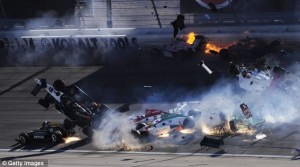To the sporting snobs who dismiss car racing as a simple-minded, redneck sport (especially those who’d rather sit around for hours watching pot-bellied men club and chase a little ball over manicured lawns until – with all of the suspense of watching paint dry – they manage to plunk it into a little hole in the ground), I have news for you:
IndyCar racing is a sport that requires the steady hands of a surgeon, the daring skill of a jet fighter, and the physical stamina of a marathon runner. And no sport can match the sustained thrill, nail-biting anxiety, and death-defying excitement one gets from watching those Indy cars zoom around the track – jockeying for position at an average speed of over 220 mph … for 500 miles!
(Female driver makes history at Indy Speedway, The iPINIONS Journal, May 31, 2005)
As this quote clearly attests, I’m an avid fan of IndyCar racing. Indeed, it’s because I am such a fan that I decided to wait three days – to give Dan Wheldon’s family, friends, and fellow drivers a little time to grieve his death – before commenting on this tragedy.
 No doubt you’ve seen the video of the 15-car crash that killed the two-time Indianapolis 500 champion (driving car #77) at the Las Vegas Motor Speedway on Sunday. But, unlike other commentators, I don’t blame the media for catering to our macabre interest by replaying the dramatic footage of this pile up ad nauseam.
No doubt you’ve seen the video of the 15-car crash that killed the two-time Indianapolis 500 champion (driving car #77) at the Las Vegas Motor Speedway on Sunday. But, unlike other commentators, I don’t blame the media for catering to our macabre interest by replaying the dramatic footage of this pile up ad nauseam.
After all, being able to see this crash as it happened – complete with racetrack views from cameras mounted in the cars involved … including Wheldon’s – is virtually orgasmic compared to the rubbernecking we all engage in every time we come across an accident on the highway.
I’m sure this is why NBC’s TODAY led off yesterday’s show (for a second-consecutive day) by replaying the video of this crash continually under the guise of reporting on safety measures that must now be implemented to prevent similar crashes in the future. The producers knew that, even though some hearts would break with each replaying, all eyes would remain glued to marvel in every gory, thrilling detail.
Apropos of new safety measures, many people are pointing to NASCAR as an exemplar. But I’m mindful that it took the death of Dale Earnhardt Sr. for NASCAR to make changes to increase driver safety. And I’m confident that Wheldon’s death will compel Indy to do the same.
We should all be mindful, however, that there are only so many measures Indy can implement before destroying the intrinsic nature of the sport. Frankly, instead of a quixotic quest to make IndyCar racing death proof, industry officials should stress how remarkable it is that drivers routinely race, and even crash, at speeds in excess of 225 mph without suffering any injuries at all.
 Alas, there’s no gainsaying that inherent in the death-defying excitement we get from watching car races is the likelihood that we might see a spectacular crash. Imagine the disappointment of going to a hockey match and not seeing a fight. And there’s the rub; because as much as we wish for the crash, nobody wishes for anyone to die.
Alas, there’s no gainsaying that inherent in the death-defying excitement we get from watching car races is the likelihood that we might see a spectacular crash. Imagine the disappointment of going to a hockey match and not seeing a fight. And there’s the rub; because as much as we wish for the crash, nobody wishes for anyone to die.
More to the point, though, nobody knows of the risks inherent in car racing than the drivers themselves. This is why instead of bemoaning the track conditions that contributed to his death, Wheldon’s family issued a statement emphasizing the fact that he died doing what he loved. We should all be so lucky.
Nevertheless, as the title above intimates, many people are saying that replaying the video of his fatal crash shows gross insensitivity towards his family. I submit, however, that replaying it ad nauseam shows no greater insensitivity towards them than replaying the video of those planes crashing into the Twin Towers on 9/11 shows towards the surviving families. And Lord knows the mainstream media have replayed that 9/11 video tens of thousands of times since then.
The official report is that Wheldon died from “unsurvivable head injuries”. He is survived by his wife and their two young sons. He was 33.
Related commentaries:
Female driver makes history…